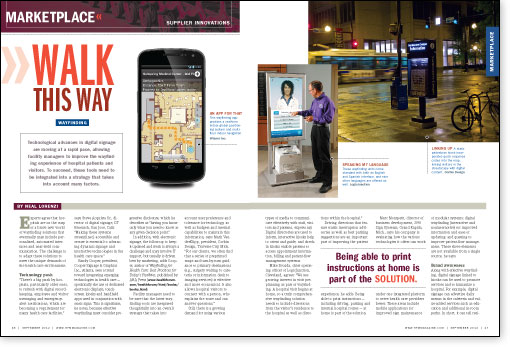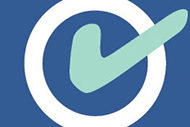
Technological advances in digital signage are moving at a rapid pace, allowing facility managers to improve the wayfinding experience of hospital patients and visitors. To succeed, these tools need to be integrated into a strategy that takes into account many factors.
Experts agree that hospitals are on the cusp of a brave new world of wayfinding solutions that eventually may include personalized, automated interfaces and near-field communication. The challenge is to adapt these solutions to meet the unique demands of the health care environment.
Technology push
"There's a big push by hospitals, particularly older ones, to refresh with digital recordkeeping, employee and visitor messaging and emergency-alert notifications, which are becoming a requirement for many health care facilities," says Steve Acquista Sr., director of digital signage, DT Research, San Jose, Calif. "Making these systems streamlined, accessible and secure is essential to advancing dynamic signage and interactive technologies in the health care space."
Randy Cooper, president, Cooper Signage & Graphics Inc., Atlanta, sees a trend toward integrating emerging technologies in health care — specifically the use of dedicated electronic displays, touch-screen kiosks and handheld apps used in conjunction with static signs. This is significant, he notes, because effective wayfinding must consider progressive disclosure, which he describes as "having you know only what you need to know at any given decision point."
In addition, with electronic signage, the follow-up to keep it updated and fresh is always a challenge and may involve IT support, but usually is driven best by marketing, adds Cooper, author of Wayfinding for Health Care: Best Practices for Today's Facilities, published by AHA Press (www.healthforum.com/healthforum/html/books/books.html).
Facility managers need to be sure that the latest wayfinding tools are integrated thoughtfully into an overall strategy that takes into account user preference and tolerance for technology, as well as budgets and internal capabilities to maintain this information, says Mark VanderKlipp, president, Corbin Design, Traverse City, Mich. "For our clients, we often find that a series of preprinted maps and turn-by-turn guidance to primary destinations (e.g., surgery waiting to cafeteria or information desk to imaging services) is effective and more economical. It also allows hospital visitors to connect with a person, who explains the route and can answer questions."
Still, there is a growing demand for using various types of media to communicate effectively with staff, visitors and patients, experts say. Digital directories are used to inform, interactive kiosks help to orient and guide, and check-in kiosks enable patients to access appointment information, billing and patient-flow management systems.
Mike Drozda, chief operating officer of LogicJunction, Cleveland, agrees: "We see growing interest in visit preplanning as part of wayfinding. A hospital visit begins at home, so a truly comprehensive wayfinding solution needs to include directions from the visitor's residence to the hospital as well as directions within the hospital."
Driving directions that feature traffic interruption advisories as well as best parking suggestions are an important part of improving the patient experience, he adds. Being able to print instructions — including driving, parking and internal hospital routes — at home is part of the solution.
Marc Montpetit, director of business development, 2/90 Sign Systems, Grand Rapids, Mich., says his company is evaluating how the various technologies it offers can work under one integrated platform to serve health care providers better. These areas include mobile applications for improved sign maintenance of modular systems; digital wayfinding (interactive and noninteractive) for improved information and ease of updating; and queuing to improve patient-flow management. These three elements are not available from a single source, he says.
Brand awareness
Along with effective wayfinding, digital signage linked to kiosks can be used to promote services and to humanize a hospital. For example, digital signage can advertise daily menus in the cafeteria and value-added services such as education and additional in-room perks. In short, it can tell residents and guests about services they may not know about.
"The health care campus provides a canvas on which an organization can paint its brand, promote its core values, and brighten and demystify an environment that many patients and visitors enter with trepidation," says Erin Doherty, director of marketing, Four Winds Interactive, Denver.
Digital donor walls encourage philanthropy by celebrating donor contributions, reflecting and amplifying a hospital's core message and enabling increased on-site activity, for example. Content, which may include reasons for giving, graphics and video of survival stories and the rich history of caregiving at the facility, creates a humanity-driven appeal. By providing touch-screen capability, viewers can access content from the sign and learn about various levels of contributions.
Likewise, patient waiting room displays and pharmacy boards reduce perceived wait times and often are deployed to include recovery, patient guidance, wellness advice and drug interaction precautions. Any video, graphic or text content can be presented. Distribution mechanisms can be used to direct prerecorded content to specific rooms through a video distribution network. If content is on a website, facility managers can use a Microsoft tag or a quick-response code, so patients can capture information on smart phones or tablets.
Acquista of DT Research looks at signage systems as either inward-facing, which address employee messages and staffing, or outward-facing, for public areas such as waiting rooms and lobbies. "You have to make sure the signage system is flexible for both; you don't want two different systems, or one that isn't flexible enough," he explains.
He says DT Research can give contributors permission-only access to specific message areas on the screens, allowing them limited access and management of those parts of the system.
Integrating digital and conventional signage is a key to success, experts agree. "This is a process that involves a number of players: project architect, owner/owner's rep, technology/audiovisual consultant, manufacturer," says Nate Larmore, principal-in-charge of technology services for the Seattle-based technology consulting firm Sparling. He sees this situation changing as technology-based wayfinding is viewed less as a one-for-one replacement of conventional signage and treated more as a patient experience enhancement tool.
"Current digital solutions are flexible and can display directional information in a more appealing and aesthetic fashion," he notes. "As we evolve beyond the one-for-one approach, we'll see wayfinding solutions, digital content displays and human experience enhancements all brought together to deliver innovations that are designed to create specific experiences for patients and others who use the health care facility."
Even smarter phones
Advances in technology also have integrated smart phone applications with patient-flow management systems, allowing patients to check in prior to arrival via their mobile devices. This allows hospitals to accommodate the incoming flow of patients and provide estimated wait times.
One such smart phone application is available from Wifarer Inc., San Jose, Calif. The company offers a portable wayfinding solution that enables people to carry the hospital directory, real-time interactive directions and relevant content in the palm of their hands, rather than search for a digital kiosk, sign or information booth, according to Lise Murphy, vice president of marketing.
"The app's skin, content and maps can be quickly and easily modified by hospital administration using our cloud-based content management system, with changes appearing instantly on the app," she explains. "This means that as clinics move, staff changes and office hours are modified, the app is always up-to-date. Hospital administration decides which information will enrich their users' experience."
VanderKlipp of Corbin Design agrees that smart phone capabilities are increasing by leaps and bounds. However, mobile solutions have been lagging for health care applications. "Typically, you see mobile solutions created for civic, retail, entertainment or other purposes, but they are not always feasible for health care," he says. "Hospitals often have older populations who are less willing to download an application or use their data minutes to seek out mobile information." This will change as technology and adoption improve, but it will take time, he adds.
Looking ahead
With digital signage technology advancing at a rapid pace, experts are able to offer plenty of predictions for the near future. "OLED (organic light-emitting diode) screen technology will make architectural integration much easier because the screens will be unbelievably thin and easier to integrate within custom shrouds," says Andy Shevak, general manager, digital signage, ASI Sign Systems, Dallas. These screens, which require no backlight or filters (unlike liquid-crystal displays), are said to offer brilliant colors, a fast response rate and a wide viewing angle.
"Some of the technology changes we are watching include: glassless 3-D displays; thinner and larger display sizes; increased wireless availability and bandwidth," says Montpetit of 2/90 Sign Systems. "As bandwidth and wireless availability increase, so will the opportunity to place additional digital content in areas that may not have been available before."
In the near future, Drozda of LogicJunction sees:
- more universal utilization of smart phones, even among older hospital visitors;
- personalized automated interfaces for admission, discharge and post-discharge education;
- adaptive spaces that will transform the look of a hospital room into a familiar environment when triggered by a patient identifier, such as a near-field communication device or radio-frequency identification.
Neal Lorenzi is a freelance writer based in Mundelein, Ill.
| Sidebar - For more information |
| For further details on the disinfecting products featured in this month's Marketplace article, readers can contact the following vendors: ASI Sign Systems Cooper Signage & Graphics Inc. Corbin Design DT Research Four Winds Interactive LogicJunction Wifarer Inc. 2/90 Sign Systems |



